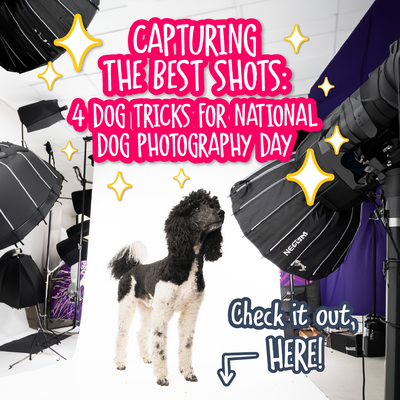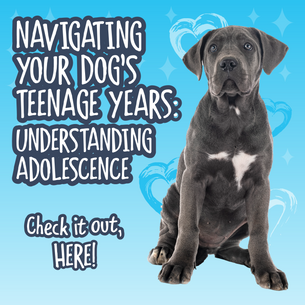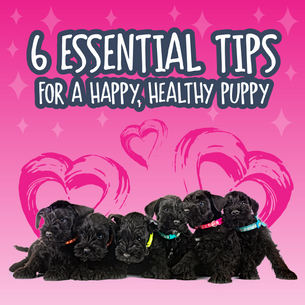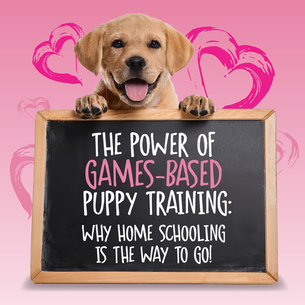Do you scroll through your camera reel and notice that nearly every other photo is of your dog? Of course, we dog-lovers need no excuse to snap more pictures of our dogs, but as National Dog Photography Day approaches, it’s the perfect time to celebrate this joyful obsession so many of us share! Whether you’re looking to get a little more creative with your shots, or you struggle to capture the essence of your dog's personality, join us as we share four top tricks for taking the very best photos.
Preparing Your Dog for a Photoshoot
Before you start snapping away, it's important to make sure your dog is comfortable and relaxed. A dog who is worried by the equipment or uncomfortable with the pressure of the situation won’t enjoy the experience - and the end result will be disappointing photos and a potential withdrawal from your relationship bank account with your dog.
Here at Absolute Dogs we are firm advocates of training FOR the situation and making sure your dog has the skills they need to handle experiences they are going to be faced with. Think about the following:
Novelty and optimism around equipment
Flashes, shutter sounds, and photography equipment can all be pretty alarming to a dog who hasn’t encountered them before. If you’re simply taking snaps of your dog on your phone there is less for them to contend with in the way of novelty. However, if you’re considering taking your dog to a professional photographer for a photo shoot, preparing them in advance will be vital in order to get the best out of the experience.
Talk to your photographer ahead of time and get a feel for where they plan to take photos, any expectations they might have of you and your dog, and what equipment they will be using.
Games like Novelty Surprise Party, Knock Em Over and Crazy Lady, which you can discover in Games Club, are great for helping your dog learn to be cool with unpredictable noises - and can be adapted to help prepare them for their photo shoot!
Scatter some of your dog’s daily food around some novel items that are safe and appropriate for your dog to interact with, and once your dog is taking the novelty in their stride, add an umbrella to the party to help acclimate your dog to the less familiar photography equipment they might encounter.
Pairing the sounds of shutter clicks and the flashes of lights with a positive outcome (some yummy food) is another great way to prepare your dog for their moment in the spotlight. Be careful not to overwhelm your dog - the aim is to create a great positive pairing and help your dog take the experience in their stride.
Check out the free Absolute Dogs Optimism Rocks eBook for more super confidence boosting games you can play at home.
Think about location
If you’re taking your own photos, consider where your dog is most relaxed and comfortable. You’ll get the best candid shots of your dog if they feel at ease and are enjoying the experience. Set them up for success by planning your photo shoot somewhere that’s free from distractions and interruptions.
Be aware of pressure
Some dogs find being photographed quite intimidating and pressured, while others lap up the attention and love to pose. Work with the dog in front of you and know their limits. Be patient and keep sessions short to prevent your dog from getting overwhelmed.
Invest in calmness
Calmness is such an important concept for every dog, and one that will set your dog up for the very best success in every aspect of life. Alongside optimism, it’s going to be a gamechanger for getting those awesome snaps. After all, a dog who is unable to sit still or settle in a new environment isn’t the best candidate for blur-free photos!
Check out the free Absolute Dogs Calm eBook for amazing tips, games and strategies for building that king of all concepts.
Top Dog Tricks for Picture Perfect Shots
So, you’re confident your dog has the skills to handle the experience - maybe even thrives on being the centre of attention - but how can you take your photos to the next level?
There are so many fun tricks you and your dog can work on together that will elevate the photos on your camera reel to a whole new level, and take your Instagram feed to the realm of viral sensation! And of course, with the Absolute Dogs concept-based approach to trick training you’ll be working on those core concepts that are fundamental to all great behaviour at the same time!
You and your dog might already be fans of trick training, in which case you’re well on your way to having some super poses you can use to add flair and pzazz to your pics.
If you’re new to the wonderful world of tricks, check out our top tricks you can teach your dog, that will turn an average photo into a truly spectacular one.
Trick 1: Sleepy
Sleepy (sometimes known as Head Low) is a lovely trick for getting those adorable camera shots that will enhance your photos or social media posts.
On a practical level, it’s also a great trick for grounding your dog and growing stillness and calmness.
It’s a trick that can be taught by luring or shaping the behaviour, or you use a target to help your dog learn. Many dogs adopt a “Sleepy” position naturally when relaxing, in which case it’s a relatively easy one to capture too. The method you use will ultimately depend on how your dog learns best. The step-by-step below uses a target.
Step 1
Start with your dog in a sit or a down position. Kneel in front of them and hold your hand or a small target (coasters work well) slightly under their chin. Use food in your other hand to lure their head gently downwards until they lower their chin onto your hand or target to reach the food. Mark and reward as soon as they hit the target.
Step 2
Once they understand the task, remove the target and place your hand behind your back. Present it again and see if they offer the behaviour spontaneously. If they place their chin onto your hand or target, reward and then throw a piece of food away to reset for another attempt. Continue to lure as needed.
Step 3
Once your dog is consistently placing their chin on your target, gradually increase the duration by waiting longer before marking and rewarding. Keep the sessions short and enjoyable.
Top Tip: If your dog finds the chin target challenging, try offering them something soft like a pillow to rest their chin on. Once they grasp the concept, you can then transfer the behaviour to other objects.
Step 4
Once your dog has a reliable chin target to your hand or a target object, you can gradually lower the target towards the floor so that they transfer that behaviour and begin putting their chin flat on the ground. Don’t expect to get this in one session. Lower your target a little more on each repetition as your dog continues to succeed, putting lots of value into the behaviour so they understand what is being reinforced.
Step 5
Once your dog understands the ‘game’ is to lower their chin to the ground, you can fade out the target and replace it with a more subtle visual cue. To do this, give your visual cue, pop your target down, wait for them to lower their chin, then mark and reward.
Repeat this in lots of short, fun sessions until your dog is reliably associating your visual cue with the behaviour and is able to offer it when cued. You can then remove the target.
Step 6
With your behaviour happening consistently on a visual cue, you can start to build in some duration.
Trick 2: Crossed Paws
Not only is this trick a particularly cute pose for photos, it’s also a great way to add a level of variation and flexibility to your dog’s paw targeting skills - giving your dog a great mental workout too!
Crossed paws also gives your dog a great shoulder stretch to add into their fitness and stretching routines.
Step 1
With your dog in a down, begin by asking them to touch one paw to a small target. If your dog knows how to give a paw, you’ll have a head start. Mark and reward every time their paw hits the target so they pair the action of pawing the target with getting the reward.
Step 2
When your dog is reliably touching their paw to the target each time you present it, move the target slightly closer to the paw that’s on the ground. Build up in lots of small increments, gradually moving your target further over and across that opposite leg, marking and rewarding as your dog continues to find the target with their paw.
Step 3
You will eventually get to the point where you can pop the target on the ground and ask your dog to target it by crossing the paw you have been working with over the other.
Step 4
When your dog is consistently crossing one paw over the other, you can start fading out the target.
Top Tip: Only level up after lots of successful repetitions using the target. If your dog gets stuck, go back a stage and put more value into the behaviour and make sure your dog understands what you’re asking them to do.
Work on both sides to maintain your dog’s mental and physical flexibility. Be prepared for your dog to have a dominant side and find it much easier to learn the trick in one direction than the other.
Trick 3: Shy
Teaching your dog to hide their face with a paw is a really cute trick to add to your repertoire. If you build in some distance and duration so your dog is able to hold the pose, it’s a great one for photos too.
As with all tricks, it can be taught in several ways. One way of capturing the behaviour is by using something gently balanced across your dog’s muzzle, so they become aware it is there and paw it off. Marking and rewarding that moment the paw touches the muzzle allows you to capture the gesture and then quite quickly fade out the object.
Sticky Notes are often used because they are lightly tacky. You might prefer to balance a piece of fabric or an old sock across your dog’s nose. This method has the potential to test your dog’s tolerance, so it’s not going to be the right way of teaching every dog - and short sessions are a must. If it ever appears your dog isn’t enjoying the experience, target training or luring are great alternatives. Remember, trick training should always be fun!
As with all the tricks we’re sharing here, you can explore alternative methods in our super trick training book, There’s A Trick For That!
Step 1
With your dog in a sit, gently attach a small, appropriate item to your dog’s muzzle. Mark and reward any movement of their paw toward their nose.
Step 2
Replace the item and repeat the steps. Build lots of value for this stage so your dog is clear that a paw across their nose equals a reward. Some dogs find a visual cue helpful so they can copy your movement.
Step 3
Add a verbal cue when they are reliably swiping the object off. This pairs the action with the verbal cue.
Step 4
See if your dog is able to perform the behaviour on your verbal cue without an item to swipe off. Go back a step if necessary.
Important considerations
This is probably not a trick you’re going to want to teach if your dog wears a head collar and already has a habit of trying to remove it with their paws. Tricks should build purposeful skills, not hinder your training!
Trick 4: Hug
Teaching your dog to hug is another firm favourite, and one that is naturally paired with Sit Pretty for an adorable trick that will make for amazing photo opportunities.
Prerequisite: Sit Pretty
Although you can work on the early stages of hugging without your dog knowing Sit Pretty, it will be a prerequisite if your ultimate goal is for your dog to be able to sit back on their haunches and hold a toy in their ‘arms’.
You can teach your dog Sit Pretty in Middle. This is a great way of providing the support your dog is going to need in the early stages while they are building the core and back strength required to support themselves safely in position.
Step 1
Ask your dog for Middle and cue them to sit. Be sure they are comfortable being close to your legs with your feet near their back paws.
Step 2
Hold a piece of food above their head and directly over their nose. Slowly lure upwards so they have to stretch to reach the food. The goal is for them to rock backwards against your legs and sit up straight on their haunches as they take the food.
Step 3
Keep your sessions short and slowly build their core strength and stability before adding duration. Be mindful of reward placement to ensure their neck and spine stay in the proper alignment.
Step 4
Once they are able to support themselves, take them out of Middle and try positioning them in a corner so they still have support if they need it. If they lean into the corner, spend more time building core strength and balance. This trick asks a lot of them so limit each session to a few repetitions each time you practise.
Step 5
When they can easily support themselves in position, start building small amounts of duration in front of you or at your side.
Safety First
It’s important to remember how much core strength, stamina and balance is required for your dog to perform a Sit Pretty with good form and duration before you add the additional layer of complexity required to hug an object. This is not a trick that’s appropriate for every dog, so if in any doubt, check with a qualified professional.
Introducing the Hug (hold an object)
Step 6
Begin shaping the hug by having your dog paw target a pole or similar item.
Step 7
Mark and reward every attempt to target the pole with one or both paws. Keep the pole close to your dog’s body to maintain correct neck and spine alignment.
Step 8
Jackpot reward whenever your dog wraps their forelimbs around the pole. Experiment with different objects and find what your dog naturally grips.
Step 9
Gradually add duration by delaying your mark and reward. Short, fun sessions are key.
Step 10
Challenge your dog by briefly letting go of the pole. Do they maintain their grip? Make use of their opposition reflex to encourage them to hold tight.
Step 11
Once your dog masters the hug, introduce different items.
For trick training solutions galore, check out our super Trick Training Collections.
And be sure to check out our Tricks Tuesday posts each week on Facebook and Instagram, where we share the step-by-step for another fun trick and give you a sneak peek into our super book!
Hold That Pose!
Of course, there’s another consideration for awesome photos. To get those really great shots, you’re going to want to be able to add distance and duration to all those spectacular tricks. If your dog shifts position or gets up to follow you the moment you move, your window of opportunity for snapping a winning picture will be limited.
“Break!”
Release cues are one way to achieve this. If your dog understands that a cued behaviour should be maintained until they are released, you are much more likely to get consistent duration behaviour and a dog who is able to hold position.
Duration
When thinking about the best way to add duration to any trick you’re teaching, it’s also important that your dog understands duration as a concept.
This is often best taught with a behaviour your dog already knows well and enjoys doing (perhaps a sit or a down). Feeding while your dog maintains position provides clear information that the cued behaviour is ongoing.
Once your dog understands a particular behaviour or trick, cuing that behaviour and then playing around with your reward delivery and elongating your reward experiences allows you to add duration incrementally.
Choice Games
Incorporating games which require your dog to make choices - and which link those choices to desirable outcomes - is a powerful way to help them learn to hold position, demonstrate control and build duration while they wait for you to deliver that reward.
Here at Absolute Dogs we love to Ditch the Bowl. This revolutionary approach means your dog learns to value the experience you are delivering with that food way more than simply having value for the food itself.
This is such an important building block to have in place for your trick training and for every aspect of life with your dog! Games such as Mouse Game, OK Go, Aeroplane Game and Food Fiddling all help build this understanding.
We dive into this in much more detail in There’s A Trick For That! but here’s a taster that will help you add both duration and distance to your dog’s tricks.
Aeroplane Feeding
Cueing your dog into a position and then slowly feeding to their mouth (much as you would aeroplane food on a spoon to a child), is one way to proof that position and add duration. You can take this further by holding food in different positions in your dog’s eye line and watching to see that they can maintain their position - and even dig in a little harder and be really gritty about it.
By having the impulse control needed not to reach forward and take the food before you deliver it or to jump out of position to steal it, you are really adding value and duration to that behaviour.
Remember, this is built on a foundation of creating rewarding experiences with your dog’s food so that they really value the experience you are creating, not just the food itself.
Food Fiddling
This works in much the same way. As the name suggests, this is where you fiddle around with the food reward in your hand before delivering it to your dog.
By elongating the reward experience and asking your dog to hold a position while you fiddle with food in front of them before delivering pieces to them, they have to maintain position and control.
Props, Equipment and Top Photography Tips
So your dog is a tricks pro - ready to pose for your photoshoot. What else might you want to consider?
Choosing the Right Camera and Settings
Amateur photography can achieve some stunning results, and, with the right conditions and a perfect canine candidate, smartphones can take great photos. If you do want to invest in a more professional set up, a DSLR camera can offer more control and better quality.
Use a fast shutter speed to freeze motion, and a wide aperture for a pleasing background blur.
Utilising Natural Light and Backgrounds
Good lighting and backgrounds can enhance your dog photos. Shoot during the golden hours (early morning or late afternoon) for soft, flattering natural light, and choose simple, uncluttered backgrounds that make your dog the focal point of the image.
Get down to your dog’s level
For best results, don’t be afraid to get down low! Experiment with angles and really become part of your dog’s world. Depending on the size of your dog, you may have to crouch with your camera or lie on your belly just to level the camera with your pooch.
Pay your model!
Rewards are so important. Taking photos of your dog should be a positive experience which your dog is happy to participate in. Know what motivates your dog and whether you are more likely to get the best out of them with toys or food.
Be prepared to make funny noises to grab your dog’s attention, get their focus or create a look of surprise that will allow you to capture that perfect shot!
Number one - have fun!
This is the very best way to capture your dog’s personality. You want them to feel relaxed and joyful so that your photos capture the essence of their personality.
Are you ready to grab your camera, get creative, and capture some unforgettable moments with your dog this National Dog Photography Day?




